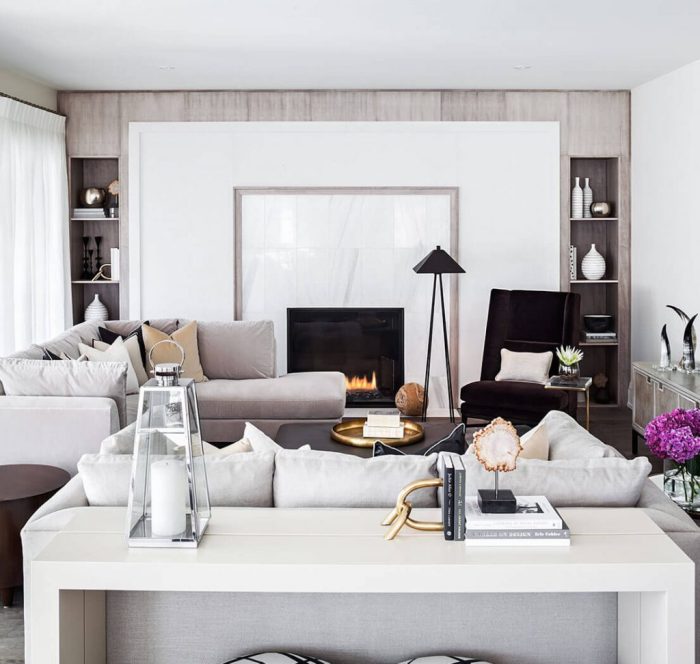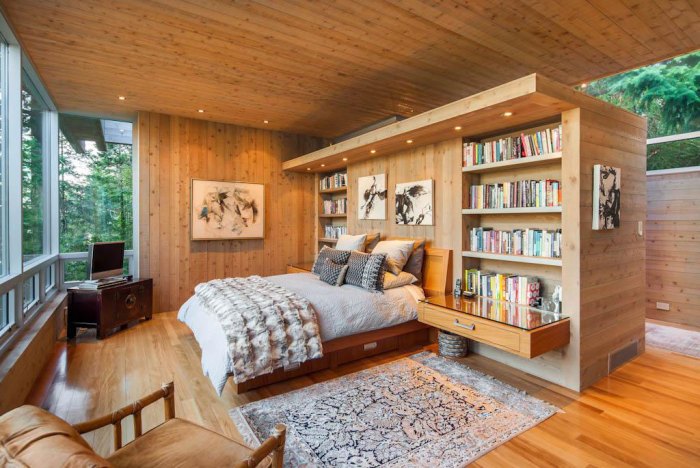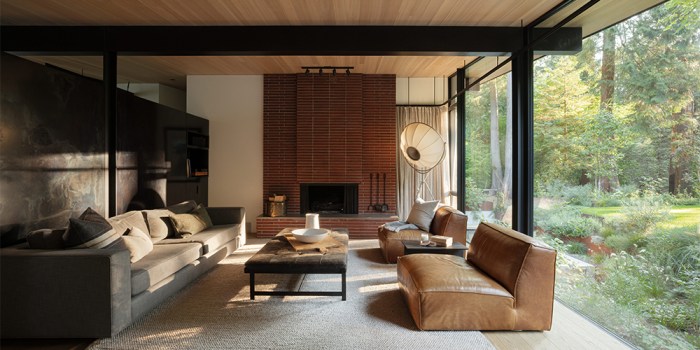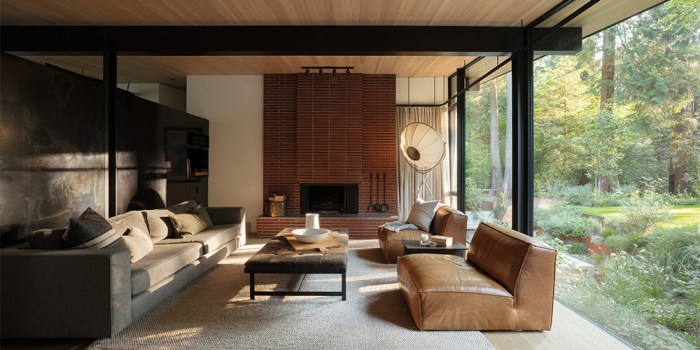Canada House Interior Design sets the stage for a captivating exploration of style and functionality, showcasing the unique blend of modern trends and timeless traditions that define Canadian homes. From the rustic charm of a modern farmhouse to the minimalist elegance of Scandinavian design, Canadian interior design embraces a diverse range of aesthetics.
This guide delves into the evolving landscape of Canadian home design, examining the influence of regional variations, cultural influences, and the growing importance of sustainable practices. We’ll explore color palettes, material choices, and lighting techniques that create inviting and functional spaces, while highlighting the role of technology in shaping the future of Canadian home design.
Lighting and Natural Light
Lighting plays a crucial role in shaping the ambiance and functionality of any interior space, especially in a Canadian home. It not only illuminates the room but also influences our mood, perception, and overall well-being. Proper lighting design is essential for creating a welcoming, comfortable, and aesthetically pleasing environment.
The Importance of Lighting in Canadian Homes
The Canadian climate, with its long winters and shorter days, presents unique challenges for interior lighting design. Natural light plays a significant role in maintaining a positive mood and promoting a sense of well-being. However, during the winter months, natural light is limited, making artificial lighting crucial for creating a comfortable and functional living space.
Natural Light
Maximizing natural light is essential for a Canadian home, especially during the winter months. Large windows, skylights, and light wells can help to flood the interior with natural light, creating a bright and airy atmosphere.
Maximizing Natural Light
- Large Windows:Using large windows to maximize natural light is a common strategy in Canadian homes. These windows can be strategically placed to allow sunlight to penetrate deep into the interior, illuminating even the darkest corners.
- Skylights:Skylights are particularly effective in bringing natural light into rooms with limited window space, such as bathrooms, kitchens, and hallways. They can also help to reduce the need for artificial lighting during the day.
- Light Wells:Light wells are vertical shafts that bring natural light into lower levels of a house. They are often used in basement apartments or multi-level homes, allowing natural light to reach areas that would otherwise be dark.
- Light-Colored Walls and Flooring:Light-colored walls and flooring reflect natural light more effectively, creating a brighter and more spacious feeling.
- Mirrors:Mirrors can strategically placed to reflect natural light and enhance the sense of brightness.
Artificial Lighting
Artificial lighting is essential for creating a comfortable and functional living space, especially during the evening hours and during the winter months.
Types of Artificial Lighting
- Ambient Lighting:Ambient lighting provides general illumination for a room. It is typically achieved using ceiling fixtures, such as chandeliers, pendant lights, or recessed lights.
- Task Lighting:Task lighting provides focused illumination for specific activities, such as reading, cooking, or working. It can be achieved using desk lamps, under-cabinet lighting, or track lighting.
- Accent Lighting:Accent lighting highlights specific features of a room, such as artwork, sculptures, or architectural details. It can be achieved using spotlights, sconces, or LED strips.
Lighting Plan for a Canadian Home
Here’s a lighting plan for a Canadian home, incorporating both natural and artificial light sources:
Living Room
- Natural Light:Large windows facing south or west to maximize sunlight during the day.
- Artificial Light:A combination of ambient lighting (ceiling fixture) and accent lighting (track lighting to highlight artwork or a fireplace).
Kitchen
- Natural Light:Large windows or a skylight to provide ample natural light during the day.
- Artificial Light:A combination of ambient lighting (ceiling fixture) and task lighting (under-cabinet lighting for work areas and pendant lights over the island).
Bedroom
- Natural Light:Windows facing east to provide morning sunlight.
- Artificial Light:A combination of ambient lighting (ceiling fixture) and bedside lamps for reading.
Bathroom
- Natural Light:A skylight or window to provide natural light during the day.
- Artificial Light:A combination of ambient lighting (ceiling fixture) and task lighting (mirror lighting for makeup application).
Furniture and Decor
Furnishing a Canadian home is an opportunity to embrace the country’s rich design heritage and celebrate its unique aesthetic. From the rugged beauty of the outdoors to the warmth of cozy interiors, Canadian design embodies a blend of functionality, comfort, and natural elements.
Furniture plays a crucial role in defining the style and atmosphere of any interior design. By carefully selecting furniture pieces that complement the overall design concept, you can create a cohesive and inviting space that reflects your personal taste and lifestyle.
Canadian-Made Furniture and Decor
Canadian furniture and decor brands are renowned for their craftsmanship, sustainability, and innovative designs. These brands often draw inspiration from the country’s natural landscapes, materials, and cultural heritage, resulting in pieces that are both aesthetically pleasing and environmentally conscious.
- West Elm: This popular brand offers a wide range of furniture and decor items, including pieces made in Canada. Their designs often feature clean lines, natural materials, and a focus on sustainability. For example, their “Modern Farmhouse” collection showcases furniture made from reclaimed wood and sustainable materials.
- Article: Known for its modern and minimalist designs, Article sources many of its furniture pieces from Canadian manufacturers. They offer a variety of styles, from contemporary to mid-century modern, all at affordable prices.
- Elte: This Canadian furniture brand is known for its high-quality craftsmanship and timeless designs. Their pieces are often made from natural materials such as wood, leather, and wool, and they feature intricate details and handcrafted finishes. For example, their “Vancouver” sofa is made from sustainably sourced leather and features a classic design that complements a variety of interior styles.
Furniture’s Role in Defining Interior Design Styles
Different furniture styles can evoke distinct moods and create different atmospheres within a space. For example, a traditional interior design might feature ornate furniture pieces with intricate carvings and plush upholstery, while a contemporary interior design might prioritize clean lines, minimalist designs, and functional furniture pieces.
- Modern:Characterized by clean lines, geometric shapes, and a focus on functionality. Furniture pieces in this style are often made from materials like steel, glass, and leather, and they feature simple, uncluttered designs. Popular Canadian brands that offer modern furniture include Article, EQ3, and Urban Barn.
- Scandinavian:Inspired by the simplicity and functionality of Scandinavian design, this style emphasizes natural materials, light colors, and minimalist designs. Furniture pieces are often made from wood, wool, and linen, and they feature clean lines and a focus on functionality. Some Canadian brands that offer Scandinavian-inspired furniture include West Elm, CB2, and Crate & Barrel.
- Industrial:Inspired by industrial spaces, this style features raw materials, exposed elements, and a rugged aesthetic. Furniture pieces in this style are often made from metal, wood, and leather, and they feature distressed finishes and exposed hardware. Popular Canadian brands that offer industrial-style furniture include Structube, Urban Barn, and Wayfair.
Furniture and Decor Selection Guide for a Canadian Home
When selecting furniture and decor for a Canadian home, consider the following factors:
- Climate:Canada’s diverse climate requires furniture that is both durable and adaptable. For example, you might choose fabrics that are resistant to moisture and stains, or furniture pieces that can be easily moved and rearranged to accommodate different seasons.
- Lifestyle:Consider your lifestyle and how you use your home when selecting furniture. If you entertain frequently, you might choose furniture pieces that are comfortable and spacious. If you have a busy family, you might prioritize durable and easy-to-clean furniture pieces.
Canada’s diverse landscape and cultural influences are reflected in its home interiors, from rustic cabins to modern city apartments. To bring these visions to life, many designers are utilizing the power of 3d interior house design software. This technology allows them to create detailed and realistic renderings of spaces, enabling clients to visualize their dream homes before a single nail is hammered.
- Personal Style:Ultimately, the most important factor in selecting furniture is your personal style. Choose pieces that you love and that reflect your personality. You can create a unique and inviting space by incorporating pieces from different styles and eras.
Interior Design for Different Room Types: Canada House Interior Design
Interior design plays a crucial role in creating functional and aesthetically pleasing spaces within a home. Each room serves a distinct purpose, and its design should reflect its intended use. This section explores design concepts for various room types in a Canadian home, considering factors like comfort, functionality, and style.
Living Room Design for a Canadian Home
A living room is the heart of a home, where families gather, entertain guests, and relax. The design of a Canadian living room often reflects the country’s natural beauty, incorporating elements of rustic charm, modern simplicity, and cozy warmth.
Canadian house interior design often prioritizes functionality and comfort, incorporating natural elements and a sense of spaciousness. While large homes are common, compact living is also gaining popularity, leading to innovative solutions like the 40 sqm house design 2 storey interior.
This clever approach maximizes space by utilizing verticality, allowing for a comfortable living experience within a smaller footprint. Canadian interior design continues to evolve, embracing both traditional and contemporary aesthetics, showcasing the versatility of design in any space.
- Comfort:Comfortable seating is paramount in a living room. Plush sofas, armchairs, and ottomans provide a welcoming atmosphere for relaxation and conversation.
- Functionality:The layout should facilitate easy movement and flow, allowing for conversation and entertainment. Consider incorporating storage solutions like coffee tables with drawers or built-in shelves for organizing books and media.
- Style:Canadian living rooms often embrace a blend of styles, including rustic, modern, and traditional. Natural materials like wood, leather, and stone create a warm and inviting ambiance.
Bedroom Design Concept for a Canadian Home
The bedroom is a sanctuary for rest and rejuvenation. Its design should prioritize relaxation and personalized aesthetics.
- Relaxation:A calming color palette, soft textures, and dimmable lighting contribute to a relaxing atmosphere. Consider incorporating elements like a comfortable bed, plush bedding, and blackout curtains to promote restful sleep.
- Personalized Aesthetics:A bedroom should reflect the individual’s taste and personality. Artwork, decorative accents, and personal mementos can add warmth and character to the space.
Kitchen Design Trends in Canada
Canadian kitchens are evolving to reflect modern lifestyles and a focus on functionality. Trends include:
- Open-Concept Design:Open-concept kitchens are increasingly popular, creating a seamless flow between the kitchen and living areas. This design encourages social interaction and makes the space feel more spacious.
- Smart Appliances:Smart appliances like refrigerators with touchscreens, ovens with Wi-Fi connectivity, and dishwashers with automatic settings are becoming commonplace. These appliances offer convenience and efficiency.
- Sustainable Materials:There is a growing emphasis on sustainable materials in kitchen design, such as bamboo countertops, recycled glass backsplashes, and energy-efficient appliances.
Incorporating Canadian Culture and Landscape
Bringing the spirit of Canada into your home design goes beyond just aesthetics; it’s about celebrating the country’s rich heritage and breathtaking natural beauty. By incorporating elements that reflect Canadian culture and landscape, you can create a space that feels authentically Canadian and evokes a sense of warmth, comfort, and connection to the land.
Canadian Art and Textiles, Canada house interior design
Canadian art and textiles offer a unique and diverse way to bring Canadian culture into your home. They showcase the country’s artistic talent and reflect its diverse landscapes and cultural heritage.
- Indigenous Art:Incorporating Indigenous art into your home design is a powerful way to honor Canada’s First Nations heritage. From vibrant beadwork and intricate carvings to stunning paintings and sculptures, Indigenous art reflects the rich history, traditions, and spirituality of Indigenous peoples.
You can find authentic pieces from local Indigenous artists or support organizations that promote Indigenous art and crafts.
- Canadian Landscape Paintings:Canadian landscape paintings are renowned for their beauty and capture the essence of the country’s diverse landscapes, from the rugged mountains of the Rockies to the vast boreal forests and the shimmering waters of the Great Lakes. You can find prints or originals of famous Canadian landscape artists like Tom Thomson, Emily Carr, and the Group of Seven, or explore contemporary artists who are capturing the beauty of the Canadian landscape in new ways.
- Textiles and Fabrics:Canadian textiles and fabrics offer a wide range of textures, patterns, and colors that reflect the country’s natural beauty and cultural heritage. Look for fabrics featuring traditional Indigenous designs, such as the intricate beadwork patterns found in Cree and Ojibwe cultures, or fabrics inspired by the country’s natural landscapes, like the bold colors and textures of the Canadian Rockies or the delicate patterns of the Canadian wildflowers.
Canadian Decor and Natural Materials
Canadian decor and natural materials can add a touch of rustic charm and warmth to your home, bringing the outdoors in and creating a sense of connection to the land.
- Wood:Wood is a natural material that is both beautiful and sustainable. It can be used in a variety of ways, from furniture and flooring to accent walls and decorative elements. Consider using locally sourced wood, such as maple, birch, or cedar, to support Canadian businesses and add a unique touch to your home.
Canadian homes often reflect a blend of styles, from rustic charm to modern minimalism. However, a fascinating thread that weaves through many Canadian interiors is the influence of the 60s house interior design era. This influence, often manifested in bold geometric patterns, vibrant colors, and an emphasis on functionality, adds a unique touch to Canadian homes, showcasing a connection to a time of optimism and change.
- Stone:Stone is another natural material that can add a touch of elegance and durability to your home. Consider using Canadian granite, limestone, or slate for countertops, flooring, or accent walls. These materials can add a touch of rustic charm and create a sense of connection to the land.
- Animal Skins:While ethically sourced and sustainably harvested animal skins can add a touch of rustic charm to your home, it is important to consider the ethical implications and ensure that the skins are sourced responsibly. Consider using hides in a way that minimizes waste and respects the animal.
Interior Design for Small Spaces

Canada boasts a diverse range of homes, with a significant portion featuring compact living spaces. Designing for small homes presents unique challenges, demanding creativity and strategic planning to maximize functionality and aesthetics. This section explores effective strategies for maximizing space and creating a stylish and functional interior in small Canadian homes.
Space-Saving Furniture and Decor Solutions
Smart furniture choices are paramount in small spaces. Multifunctional pieces are key, offering dual or even triple functionalities. These solutions not only save space but also add a touch of sophistication and efficiency.
- Sofa Beds:These versatile pieces transform from cozy seating to a comfortable sleeping surface, ideal for small apartments or homes with limited guest rooms.
- Storage Ottomans:These ottomans double as storage compartments, providing a convenient place to store blankets, books, or other essentials, keeping clutter at bay.
- Wall-Mounted Shelving:This maximizes vertical space, creating a visually appealing display for books, artwork, or decorative items while minimizing floor space.
- Folding Tables:These tables can be easily folded away when not in use, freeing up valuable floor space. They are perfect for dining or working areas in small spaces.
- Murphy Beds:These beds fold up and disappear into a wall cabinet, providing a space-saving solution for bedrooms or guest rooms.
Designing a Small Home Interior in Canada
Designing a small home interior in Canada involves embracing a minimalist approach and incorporating design trends that enhance the sense of spaciousness.
- Light and Bright Color Palette:Using a light and bright color palette, such as white, cream, or light gray, helps to create a sense of spaciousness and openness. This is especially important in smaller spaces, as darker colors can make a room feel cramped.
- Mirrors:Strategically placed mirrors reflect light and create the illusion of more space, making a room feel larger than it actually is. Mirrors can also add a touch of elegance and sophistication to a room.
- Minimalist Decor:Keeping decor minimal and focusing on essential pieces helps to avoid clutter and create a sense of calm and spaciousness. This can be achieved by using fewer items, selecting pieces with clean lines and simple designs, and incorporating natural elements like plants or wooden accents.
- Multifunctional Spaces:Designating specific areas for multiple purposes, such as a dining area that also serves as a home office, can maximize functionality in small spaces. This can be achieved by using furniture that can be easily transformed, such as a table that can be used for both dining and working.
The Role of Technology in Canadian Home Design

Technology is profoundly impacting the way Canadians design and live in their homes. From smart home technologies to digital design tools, technology is transforming the very essence of Canadian home design, offering a blend of convenience, efficiency, and personalized aesthetics.
Smart Home Technologies
Smart home technologies are rapidly gaining popularity in Canada, allowing homeowners to control and automate various aspects of their living spaces. These technologies enhance comfort, security, and energy efficiency.
- Smart thermostats:These devices learn your heating and cooling preferences and automatically adjust temperatures to optimize comfort and energy savings.
- Smart lighting:Smart bulbs can be controlled remotely, allowing you to dim lights, change colors, and schedule lighting routines for various activities.
- Security systems:Smart security systems offer remote monitoring, motion detection, and instant alerts, enhancing home security and peace of mind.
- Smart appliances:Connected appliances like refrigerators, ovens, and washing machines offer features like remote control, voice commands, and automated scheduling, simplifying daily tasks.
Automation and Integration
Smart home technologies seamlessly integrate, creating a cohesive and automated living experience. Home automation systems allow homeowners to control multiple devices and functions through a single interface, simplifying everyday tasks and creating a more personalized and responsive environment.
“Automation allows for a seamless and intuitive interaction with your home, enhancing convenience and comfort while optimizing energy efficiency.”
Digital Design Tools
Digital design tools have revolutionized the home design process, enabling homeowners to visualize and create their dream homes with greater ease and accuracy. These tools offer a range of features, including:
- 3D modeling:Create realistic virtual representations of spaces, allowing homeowners to experiment with different layouts, furniture arrangements, and design elements.
- Virtual reality (VR):Immerse yourself in a virtual replica of your future home, experiencing the space and its features in a lifelike manner.
- Online design platforms:Offer user-friendly interfaces and pre-designed templates to guide homeowners through the design process, providing inspiration and practical solutions.
Technologically Integrated Home Interior Concept
Imagine a modern Canadian home where technology seamlessly integrates with design, creating a functional and aesthetically pleasing environment.
- Open-concept living:An open-concept living area features smart lighting that adapts to the time of day and activity, while a smart speaker controls music and provides information.
- Sustainable features:Energy-efficient appliances and smart thermostats optimize energy consumption, reducing environmental impact. Solar panels on the roof generate renewable energy, further enhancing sustainability.
- Personalized comfort:Smart blinds automatically adjust to optimize natural light and privacy, while a smart security system ensures peace of mind. A digital assistant manages schedules and reminders, freeing up time for relaxation and leisure.
Final Conclusion

By embracing the essence of Canadian culture and landscape, incorporating local craftsmanship, and prioritizing sustainability, Canadian home design is a testament to the evolving spirit of the nation. From cozy living rooms to functional kitchens and stylish bedrooms, each space offers a unique blend of comfort, functionality, and aesthetic appeal.
As we continue to explore the ever-changing landscape of Canadian home design, one thing remains constant: the desire to create spaces that reflect the warmth, beauty, and resilience of the Canadian spirit.
Commonly Asked Questions
What are some popular interior design styles in Canada?
Modern farmhouse, Scandinavian, contemporary, and industrial are some of the most popular styles in Canada. Each offers a distinct aesthetic and caters to different preferences.
How can I incorporate Canadian culture into my home decor?
You can use artwork featuring Canadian landscapes, indigenous crafts, or textiles with Canadian motifs. Consider incorporating natural materials like wood and stone, which are prevalent in Canada’s natural environment.
What are some space-saving solutions for small Canadian homes?
Multifunctional furniture, wall-mounted storage solutions, and light and airy color palettes can help maximize space in smaller homes.
What are some sustainable practices for Canadian home design?
Using eco-friendly materials, energy-efficient appliances, and responsible sourcing are key sustainable practices. You can also incorporate natural light and ventilation to reduce energy consumption.
